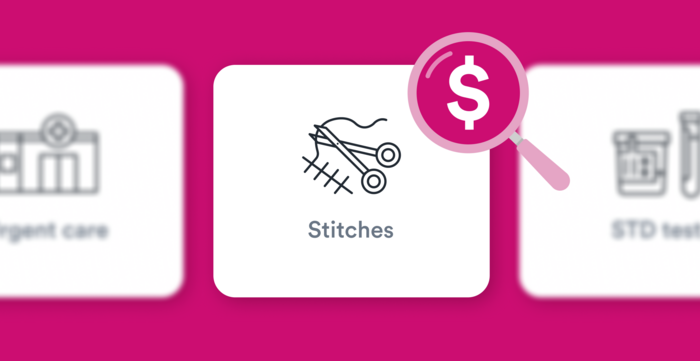Key points
- The cost of stitches without insurance varies based on factors like injury severity, location, and required medical services.
- Costs can be higher at emergency departments compared to urgent care centers.
- Additional costs may include tetanus or Tdap shots, antibiotics, or pain medication.
- The cost of stitch removal is usually included in the initial stitching cost.

You fell and got a nasty gash that’s going to require stitches. You can easily get it stitched at an urgent care clinic or emergency room. Unfortunately, you don’t have health insurance. How much are stitches going to cost without insurance?
If you have insurance, your copay should cover your part of the cost of the stitches, in most cases. Otherwise, you’ll have to pay out-of-pocket to get the wound fixed.
If you don't have health insurance, the cost to sew up that gash at an urgent care center will vary depending on how bad your injury is, where it is, and how many stitches are required, according to data collected for Solv ClearPrice TM. Deep gashes may even need two layers of stitches to repair the wound. Continue reading to learn more about what costs you can expect.
Understanding the Cost of Stitches Without Insurance
The average cost of getting stitches without health insurance can vary depending on several factors. Without health insurance coverage, individuals may face higher out-of-pocket expenses for receiving stitches, especially if they seek treatment at emergency departments, where costs tend to be higher, according to TalktoMira.com.
The cost of stitches without insurance depends on several things, including the type of healthcare facility that you’re at, the complexity of your injury, anesthesia, materials used, and any additional services required. In general, without the buffer of insurance plans, you may have to pay a higher cost for these services — potentially resulting in a significant financial burden. TalktoMira advises that uninsured individuals explore alternative healthcare options or seek out low-cost clinics to reduce the cost of expenses.
What factors impact the cost of stitches?
According to Solv’s Chief Medical Officer, Dr. Rob Rohatsch, several factors determine how much it costs to get stitches to fix an injury, including:
-
How large and deep is the cut?
-
Where is the cut located?
-
How dirty is the cut and what type of cleaning/debridement does this need?
-
Will you require anesthesia or a local anesthetic?
-
What kind of material is used (stitches, glue, or staples)?
-
Do you need other medical services such as X-rays or ultrasounds to check for internal injuries?
There also may be additional costs if you need to get a tetanus or Tdap shot to prevent further infection. Tetanus is a serious infection that can result in muscle problems, seizures, and even death. You will most likely need to get a tetanus shot if your laceration was caused by a rusty nail or implement, notes Dr. Rohatsch. A Tdap vaccine helps protect against tetanus, diphtheria, and pertussis. A tetanus shot will usually cost anywhere between $25 and $60, while a Tdap can cost a little more.
If your laceration results from an animal bite or scratch, you may be required to get treatment to prevent rabies, which could cost thousands of dollars and will also require antibiotics most of the time.
If your doctor sends you home with antibiotics or some pain medication after stitching you up, you can add the cost of those prescriptions to the bottom line. Without insurance, those prescriptions will most likely cost you more than if you had an insurance plan.
Does it cost to have stitches removed?
Stitches are usually removed five to 10 days after they’ve been added. Some stitches will dissolve, so there’s no need to go back to the doctor or urgent care facility. However, if the doctor uses sutures that don’t dissolve and require a medical professional to remove them, you will face an additional cost. The cost for the removal of stitches is usually bundled with the cost of placing the stitches. You should inquire about any fees associated with the removal of sutures.
Don’t even think about trying to remove the stitches yourself. Doing so can lead you to much larger and more expensive problems. A doctor can assess your injury to make sure it is healing correctly—with no signs of infection—when they remove the sutures.
How to Know if You Need to Get Stitches
Not all cuts will require stitches to heal. If your wound is less than ¼-inch deep and ¾-inch long, you may be able to let it heal on its own without the need for stitches, reports MedicineNet. But, you should seek immediate medical attention for injuries bigger than that. Dr. Rohatsch recommends you should also seek medical attention if your injury is:
-
A bite wound (from animal or human)
-
On your face, hands, or genital region
-
Bleeding profusely, even after applying pressure
-
Jagged in appearance
-
Gapes open
-
Dirty or contaminated
-
Located over a joint
The severity of the injury will also determine whether you can go to an urgent care facility to get stitches or if the wound requires a visit to the emergency room. Typically, for more serious lacerations that bleed heavily and expose your veins, muscle, bone, or fat, you should rush to the nearest hospital emergency room for treatment.
According to Dr. Rohatsch, you should head to the emergency room if your wound:
-
Pulses or squirts blood
-
Bleed bright red blood (as opposed to dark red blood)
-
Doesn’t stop bleeding
-
Could be associated with a fracture
If you are on any kind of blood-thinning medication, you should also have lacerations immediately attended to at an emergency room, according to MedicineNet.
Should I go to urgent care or the emergency room?
A visit to urgent care is usually more affordable because you are charged a flat rate that includes the procedure and the doctor's fees. Meanwhile, for an emergency room visit, you are charged procedure and doctor fees, and an emergency room fee can be expensive.
Under no circumstances should you even think about trying to stitch up a wound on your own. By doing so, you’ll increase your chances of getting an infection that could land you in the hospital and cost you a lot more than it will to get stitches from a trained medical professional.
How can you keep the cost of stitches under control?
If you don’t have health insurance or have insurance with a high deductible, it’s wise and perfectly acceptable to ask your health provider some questions to get a better picture of what your actual costs will be for stitches. Some of the questions to ask are:
-
What kind of stitches are they using, and what’s the difference in price?
-
Will you need a tetanus shot or follow-up medications like painkillers or antibiotics?
-
Is there a charge for the office visit on top of the cost of stitches?
-
What is the price to have the stitches removed?
How Solv can help you find a place to get stitches near you.
Getting stitches can be a scary event, not only because you’re injured, but also because the urgent care cost can be worrisome for those who have no insurance — still the average cost of getting stitches at an urgent care center is less than going to the emergency room, even if you don't have health insurance. It's important to be as prepared as possible beforehand. For all your healthcare and urgent care questions, including how to prepare for your urgent care visit, you can turn to SolvHealth.
If you are looking for an urgent care clinic that can stitch up a wound, Solv can help. Our lab finder can help you find an urgent care clinic near you.
FAQs
What factors influence the cost of getting stitches without insurance?
The cost depends on the severity and location of the injury, the type of medical facility, the need for anesthesia, the materials used for stitches, and any additional required services.
Are there additional costs to consider when getting stitches?
Yes, additional costs may include the need for a tetanus or Tdap shot, antibiotics, pain medication, and the potential need for X-rays or ultrasounds.
Is the cost of removing stitches included in the initial cost?
Usually, the cost of removing stitches is bundled with the initial cost of placing the stitches. However, it's recommended to inquire about any fees associated with stitch removal.
Are stitches more expensive at an emergency room compared to an urgent care center?
Yes, getting stitches at an emergency department tends to be more expensive due to higher procedure and doctor fees.
How can I keep the cost of getting stitches under control?
Ask your healthcare provider questions about the type of stitches used, the need for a tetanus shot or medications, charges for the office visit, and the price for stitch removal.
Should I go to an urgent care clinic or the emergency room for stitches?
The severity of the injury will determine whether you should go to an urgent care clinic or the emergency room. Urgent care is usually more affordable, but more serious lacerations that bleed heavily or expose veins, muscle, bone, or fat should be treated at an emergency room.
What happens if I don't get stitches for my wound?
If you don't get stitches for your wound, it may be harder for your wound to heal properly and you increase your risk of infection. There is usually a 12-hour window from the time you injure yourself until it is too late to get stitches.
How can I manage the cost of getting stitches?
If you don't have health insurance or have a high deductible, you can ask your healthcare provider questions about the cost of the stitches, the need for a tetanus shot or follow-up medications, any additional charges for the office visit, and the cost of having the stitches removed.









